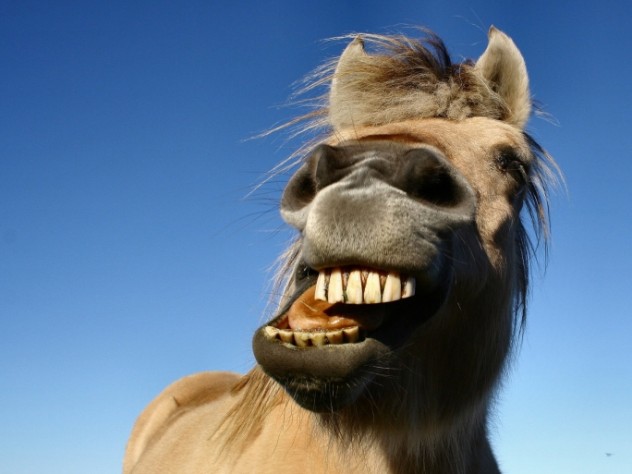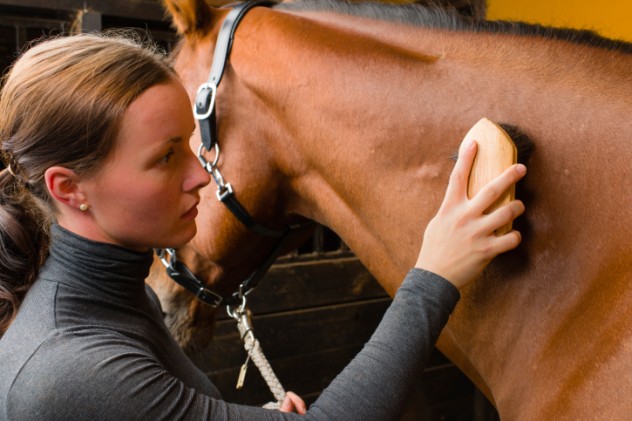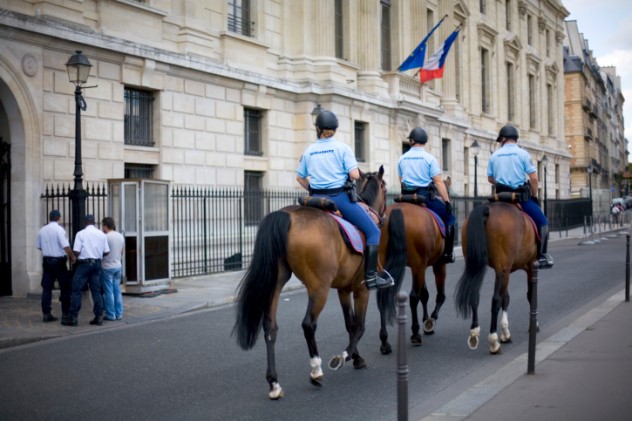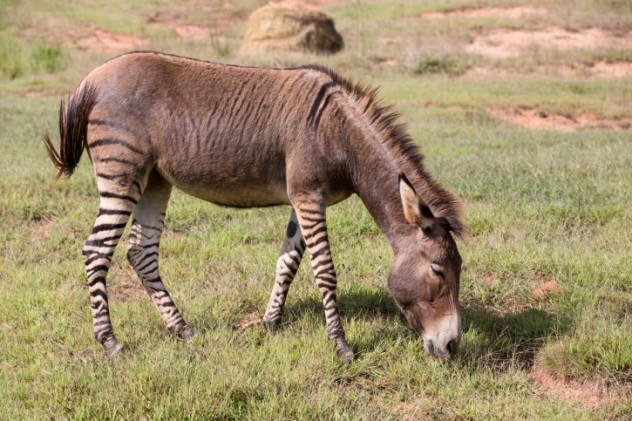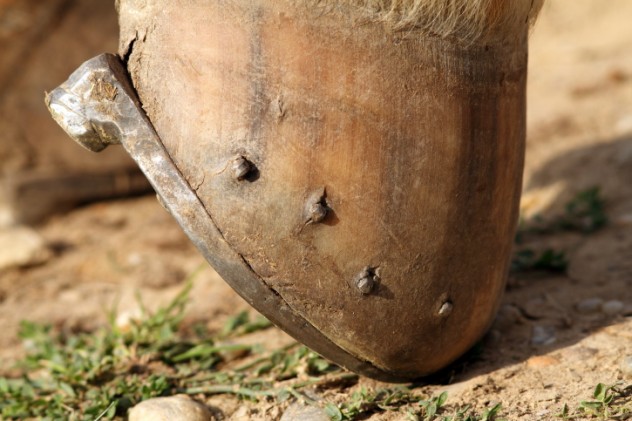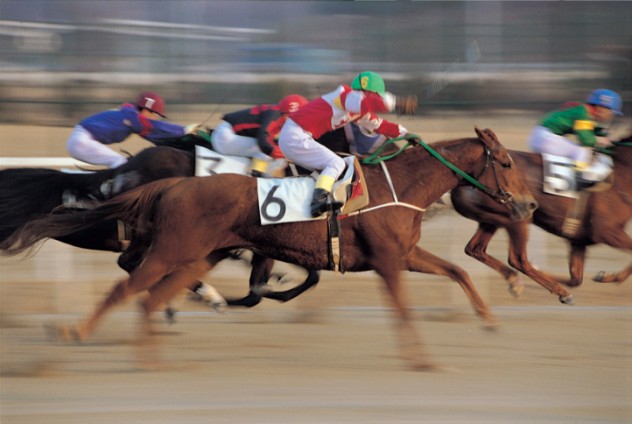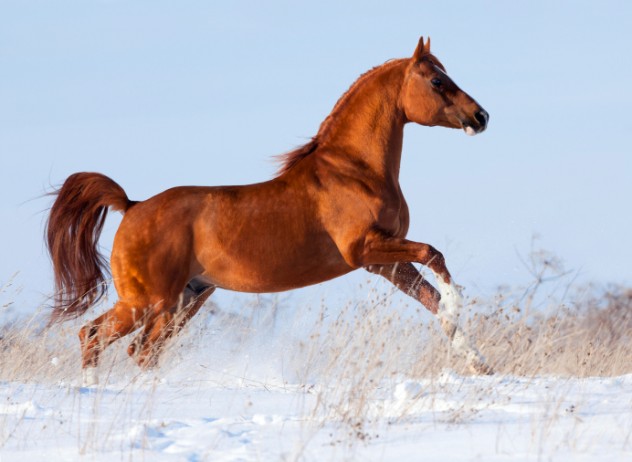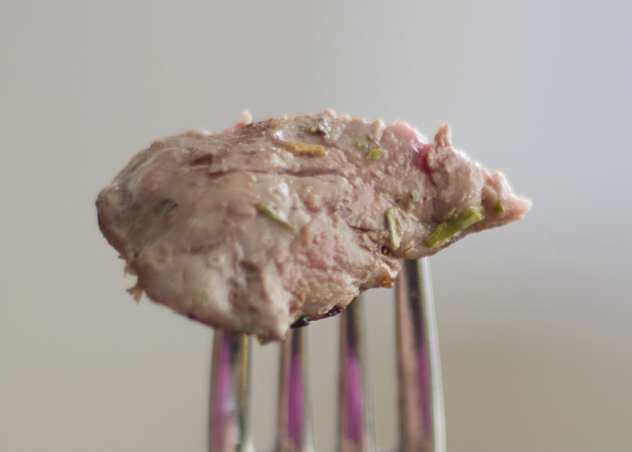10 The “Horse Laugh”
You may have seen a horse making a strange expression where it curls its upper lip and bares its teeth into a wide grin. This makes the animal look like it’s laughing. In reality, this is part of a special nose-enhancing technique called a flehmen response. Horses pull this amusing face in order to direct scents floating in the air toward special olfactory glands that are located at the end of the horse’s nasal passage. The lip-curling and the slight tilting of head help the animal to waft these smells toward these glands. The horse isn’t laughing at you, it’s just trying to determine whether you smell bad. The flehmen response is far more common in male than female horses. Much like giraffes, stallions often sample the urine of mares this way to check if they’re in heat.
9 The Horse Industry
For people who have never been involved with horses, it’s easy to assume all they need is some hay every now and then, a field to run around on, and a preteen girl or two to swoon over them. This could not be further from the truth. Horses are used for various competitions and sports, breeding, recreation, and plain old work. It takes a lot more than just a farmer and a plow to keep the show running. In fact, horses are a massive business. Approximately 4.6 million Americans work in the horse industry in one way or another. The US horse industry is estimated to have an economic effect of $39 billion—annually. That’s just the measly nine million American horses. There are approximately 58 million horses in the world and the vast majority of them are cared for by humans.
8 Police Horses
Police horses have been used in peacetime law enforcement since the 17th century and the first official mounted police unit was established in 1805. This London-based unit was a massive success, and in a few years, both Australia and America had adopted the idea. Police horses have always been much more than a mere method of transportation. The benefits of a horseback cop are obvious—after all, a police officer riding a huge animal commands a very different kind of respect than one on foot. That’s why the horses selected for the job tend to be large geldings (castrated horses), who are both imposing and level-headed enough for the potentially stressful job. The number of police horses is slowly waning due to the advent of police motorcycles and other modes of light transport, but many countries still keep a few mounted units around for public relations and crowd-control purposes.
7 Eyes
Horses have fairly good eyesight, thanks to their very peculiar eyes. At a diameter of roughly 5 centimeters (2 in), they are the largest of any land mammal. When measured in volume, a horse’s eye is up to nine times larger than that of a human. Legend has it that this means horses see things as bigger than humans, which is why they sometimes startle easily, but this is not true. The horse eye has three eyelids—two ordinary ones and a third called the nictitating membrane—which is located in the inner corner of the eye and occasionally sweeps the eye, lubricating and cleaning it if need arises. Horses can’t properly focus their eyes like humans do. Instead, the lower parts of their retina see objects at a distance, and the upper ones are for closer viewing. This means that if you want to know where a horse is looking, you should pay attention to how it’s holding its head. If you see a horse standing on a field and it’s doing that thing where it’s standing with its head held up high and ears pricked forward, it’s not just showboating—the animal is probably just looking at something interesting in the distance.
6 Equid Hybrids
Equid hybrids are, as the name tactfully suggests, hybrid animals that are bred from the three equid species—zebras, donkeys, and horses. Most people know about the mule (also known as “john” or “molly” depending on the gender), the cross of a donkey male and a horse female. However, it is only one of the many, many equid hybrids out there. One such combination is the offspring of a horse father and a donkey mother called a “hinny.” Zebras and horses can be bred into “zorses” and “hebras”, which are also known as golden zebras because, frankly, those names make the poor creatures sound like science fiction characters. Adding ponies to the mix brings even more hilarious sounding options, such as “zonies” and “zetlands.” Equid hybrids have been created since the start of the 20th century. Scientists started the work by crossbreeding zebras and donkeys, but quickly moved on to horses, presumably because they got too embarrassed to call their creations names like “zebra ass.”
5 Horse Shoes
Everyone knows most horses are fitted with horseshoes, but most people aren’t aware that these curved pieces of metal are not just to protect the hoof. The hard parts of horse hooves are made of keratin—the same sturdy protein that comprise horns, nails, and hair—and therefore leave a lot to be desired when it comes to things like traction. Imagine running around a wet, paved street wearing horns as shoes and you can see the problem. Fitting the hoof with a shoe fixes this issue. The shoe improves the traction of the hoof and provides extra shock absorption, which you may recognize as the exact same benefits your running shoes give you. That’s right—horseshoes are, more or less, equine Air Jordans. Horse shoes also share another similarity with the sports shoe industry—there is a ridiculously huge selection of different types, such as pronation-correcting support shoes, “natural balance” shoes, and even super lightweight aluminum shoes for serious racing horses.
4 Horse Names
If you’ve ever been to a horse race, you probably know that most horse names are ridiculous. Cats and dogs are usually given cute, powerful, or human-like names, but horses tend to end up with names like “Seabiscuit”, “Horlicks” or “Ohnoitsmymotherinlaw.” As random as this may seem, there are actually many traditions and superstitions associated with naming horses. Many breeders name their horses to respect its pedigree, which can lead to some unfortunate variations over time. After all, it doesn’t take many generations to twist “Binky” into “Flunky.” Naming a horse after a family member is generally avoided, because if the horse you named after your mother turns out to be a failure, Mom probably isn’t going to be too happy. Many owners prefer powerful names like “Man O’War,” because it is believed this brings the horse good fortune in the races. On the other hand, naming a horse “The Winner” is a sure fire way to create a horse that will never win a race in its life, so some owners just decide to have a bit of fun with the name. Of course, there are also actual rules governing the naming tradition. Otherwise, a horse race program would read like a list of the usernames of a particularly insane Internet discussion forum. These rules vary depending on your area. For instance, The Jockey Club of Louisville limits name length to 18 characters; forbids names that are obscene, racist, or too similar to actively competing horses; and does not allow names that are entirely made of numbers. If a horse gets famous enough, its name might be pulled from use altogether, much in the same way some sports retire the numbers of particularly legendary athletes.
3 Arabian Horses
Most horses can be quite beautiful creatures when they put their mind to it, but many people consider the Arabian horse the most majestic of all. We know that they first appeared at least 4,500 years ago, which also makes them one of the oldest horse breeds. It is generally assumed that the Bedouin, who are noted for their passion for horse breeding, are behind the creation of the Arabian breed. With its wiry, “desert” look and immediately recognizable silhouette, an Arab horse is easy to tell apart from other breeds. As peculiar as its high-tailed look and unique head shape are, things actually get even stranger when you look a little deeper. Arabian horses have a skeletal structure that is quite different from all other horses. Its ribs are much wider, stronger, and deeper, and it usually has one fewer horses normally have. It also has fewer lumbar bones and tail vertebrae. These “missing pieces” do nothing to slow it down, though—Arab horses are considered some of the strongest endurance runners in animal kingdom, capable of running over 160 kilometers (100 mi) without rest.
2 Horse Meat
Despite recent scandals that indicate otherwise, horse meat is considered a delicacy in many countries. France in particular is extremely partial not only to horse meat, but also horse brains and horse heart. The French are not alone, either. In fact, horses have been eaten as long as they’ve been around. During times of war, horses have served as an important—and relatively cheap—source of protein. In times of peace, it’s eaten because it just happens to taste good. The only countries that have never really managed to jump in the hippophage (horse-eater) wagon are also the two most influential English-speaking ones. Despite the fact that both the US and the UK are among the biggest horse meat exporters in the world, both historically scoff at horse meat as food. As such, what is not exported is usually used as pet food.
1 Memory
Have you ever laughed at a horse with a funny name? Or made fun of one when it twists its face in flehmen? If you have, that’s too bad—that horse may well remember your insult for the rest of its life. A 2010 study revealed some very surprising results about horse intelligence, especially memory. Not only does our equine friend understand our words far better than we have previously anticipated, its memory is at least as good as that of an elephant. If a horse is treated kindly, it will remember the person as a friend for as long as it lives. The horse will instantly resume friendship when it sees them again, regardless of how long they have been apart. They also remember places very well—most horses become nervous when they’re taken to a place where they’ve had a startling experience. The good memory and relatively powerful intellect of horses is not always a good thing, though. If they get bored, they can accidentally figure out how to untie themselves from posts and open latches and grain bins. Once they learn these methods of mischief, they’ll never, ever forget.
+ Eadweard Muybridge’s “Flying” Horse
Horses have helped with many of mankind’s greatest achievements, from conquering the Wild West to the postal system of ancient Mongolia, but did you know horses have also played a part in the invention of movie technology? It started in the 1870s, with a man named Leland Stanford. He was convinced that, at some point in the gallop, all four of the horse’s legs simultaneously leave the ground. His claim was met with skepticism, as horses are huge creatures that they surely must have at least some contact to the ground at all times. Certain of his cause, Stanford made a bet that he could provide indisputable evidence of its veracity. Stanford recruited photographer Eadweard Muybridge to help him in his mission. Muybridge, however, realized that camera technology at the time was far too clumsy to capture the horse at the exact time all its hooves leave the ground. Far from deterring him, he employed a completely new photography technique to accomplish his goal. He set up a series of 24 cameras side by side, each taking a picture right after the other, capturing the famed racehorse called Sallie Gardner in 24 different stages of the gallop. This not only proved Stanford’s claim—Sallie Gardner could indeed be seen with all four legs off the ground, creating the illusion that she was flying—but essentially created a 24-frame animated film. Intrigued by his new technique, he also invented the Zoopractiscope, a motion picture machine for viewing said film. Although the eccentric Muybridge remains virtually unknown by the public, his contribution to film history is undeniable and many influential people in the industry admire his genius. Currently, Gary Oldman is planning to make a movie about the story of Muybridge and the flying horse. Ralph Fiennes and Benedict Cumberbatch are reportedly attached to the project. Pauli Poisuo also writes for Cracked.com. Why not follow him on Twitter?
